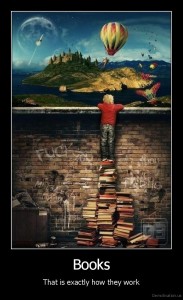It’s not upon you alone the dark patches fall,
The dark threw its patches down upon me also,
The best I had done seem’d to me blank and suspicious,
My great thoughts as I supposed them, were they not in reality meagre?
Nor is it you alone who knows what it is to be evil,
I am he who knew what it was to be evil,
I too knitted the old knot of contrariety,
Blabb’d, blush’d, resented, lied, stole, grudg’d,
Had guile, anger, lust, hot wishes I dared not speak,
Was wayward, vain, greedy, shallow, sly, cowardly, malignant,
The wolf, the snake, the hog, not wanting in me,
The cheating look, the frivolous world, the adulterous wish, not wanting,
Refusals, hates, posteponements, meanness, laziness, none of these wanting,
Was one with the rest, the days and haps of the rest,
Was call’d by my nighest name by clear loud voices of young men as they saw me approaching or passing,
Felt their arms on my neck as I stood, or the negligent learning of their flesh against me as I sat,
Saw many I loved in the street or ferryboat or public assembly, yet never told them a word,
Lived the same life with the rest, the same old laughing, gnawing, sleeping,
Play’d the part that still looks back on the actor or actress,
The same old role, the role that is what we make it, as great as we like,
Or as small as we like, or both great and small.
My Poems
Discovery of India
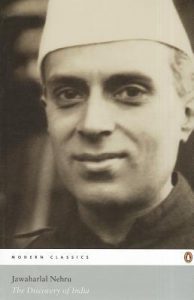 As long as Lions do not have story-tellers, the history of the hunt always glorifies the hunter. This adage is very much germane to India and its history, for it lacks historians of Indian origin in the pre-Nehru era, and much of India’s history is written by the foreigners, who visited India, with contempt and jaundiced opinions. The account of Indian history by outsiders is inveighed against Indians by marginalizing, and quoting as parochial in thought and incestually looking country. Unfortunately, this behavior is also observed in most of today’s Indians who talk glibly of modernism and modern spirit and the essence of Western culture and are at the same time ignorant of their own culture. Today most Indians take the external forms and outer trapping of the West, and imagine that they are in the vanguard of an advancing civilization. Naive and shallow and yet full of their conceits, they live an artificial life which has no living contact with the culture of the East or of the West.
As long as Lions do not have story-tellers, the history of the hunt always glorifies the hunter. This adage is very much germane to India and its history, for it lacks historians of Indian origin in the pre-Nehru era, and much of India’s history is written by the foreigners, who visited India, with contempt and jaundiced opinions. The account of Indian history by outsiders is inveighed against Indians by marginalizing, and quoting as parochial in thought and incestually looking country. Unfortunately, this behavior is also observed in most of today’s Indians who talk glibly of modernism and modern spirit and the essence of Western culture and are at the same time ignorant of their own culture. Today most Indians take the external forms and outer trapping of the West, and imagine that they are in the vanguard of an advancing civilization. Naive and shallow and yet full of their conceits, they live an artificial life which has no living contact with the culture of the East or of the West.
To my delight, here comes the man garbed in Sherwani, Cambridge-educated, who is very much misunderstood by the so-called pseudo-elites and pseudo-intellectuals of India today, who reduced this man to a mere political party — Jawaharlal Nehru. Written over five months while in prison, Discovery of India, to my mind, is a living history of India. Although the book seems disjointed, jumbled and lacks unity, the richness of Indian history and its civilization forms the sinews of the book that bind it together. Nehru’s discovery of India spans from the Indus Valley Civilization-to-Muslim Invasions-to-British Empire in India. It is a manifestation of Nehru’s quest for India’s past. Much of ink flowed from Nehru’s pen analyzing texts like the Vedas and the Arthashastra, and personalities like the Buddha and Mahatma Gandhi.
Nehru writes at length covering the iniquities, rapacities, draconian laws and conditions of British rule in India, especially the way it made India static, dormant, and imprisoned the minds of the people of India interspersed with differences between Orient and the Occident cultures. In this book, Nehru evokes Rabindranath Tagore’s thoughts and musing, which din in my ear as I read the book and also I write this review. My heart bled as I read these lines
‘ The demon of barbarity has given up all pretense and has emerged with unconcealed fangs ready to tear up humanity in an orgy of devastation. From one end of the world to the other, the poisonous fumes of hatred darken the atmosphere. The spirit of violence which perhaps lay dormant in the psychology of the West has at last roused itself and desecrated the spirit of man.
The wheels of fate will some day compel the English to give up their Indian empire. But what kind of India will they leave behind, what stark misery? When the stream of their centuries’ administration runs dry at last, what a waste of mud and filthy they will leave behind. As I look round I see the crumbling ruins of a proud civilization strewn like a vast heap of futility!
By unrighteousness man proposers, gain what appears desirable, conquers enemies, but perishes at the root.
This book is a must read for those virgin minds unassaulted by the thoughts of what India was in the past!
Tagore writes –“To know and understand India one has to travel far in time and space, to forget for a while her present condition with all its misery and narrowness and horror, and to have glimpses of what she was and what she did. To know my country, one has to travel to that age, when she realized her soul and thus transcended her physical boundaries, when she revealed her being in a radiant magnanimity which illumined the eastern horizon, making her recognized as their own by those in alien shores who were awakened into a surprise of life; and not now when she has withdrawn herself into a narrow barrier of obscurity, into a miserly pride of exclusiveness, into a poverty of mind that dumbly revolves around itself in an unmeaning repetition of a past that has lost its light and has no message for the pilgrims of the future.”
India Through My Lens!
My discovery of India
Nehru writes:
It seemed monstrous to me that a great country like India, with a rich and immemorial past, should be bound hand and foot to a far-away island which imposed its will upon her. It was still more monstrous that this forcible union had resulted in poverty and degradation beyond measure.
Rabindranath Tagore writes:
To know and understand India one has to travel far in time and space, to forget for a while her present condition with all its misery and narrowness and horror, and to have glimpses of what she was and what she did. To know my country, one has to travel to that age, when she realized her soul and thus transcended her physical boundaries, when she revealed her being in a radiant magnanimity which illumined the eastern horizon, making her recognized as their own by those in alien shores who were awakened into a surprise of life; and not now when she has withdrawn herself into a narrow barrier of obscurity, into a miserly pride of exclusiveness, into a poverty of mind that dumbly revolves around itself in an unmeaning repetition of a past that has lost its light and has no message for the pilgrims of the future.’
To my mind, India has seen and enjoyed the flowering of the world’s great traditions of philosophy, science, and art, and almost all its major religions. In other words, India is a home to all the world religions. She is a mosaic of diverse cultures, customs, creed, cuisine, color, costume, and language — and yet united, united by diversity. India had always been religious tolerant and embraced everyone including the Muslim and English invaders with courtesy and hospitality, which is a distinctive and a rare quality of accepting people from different grounds. The then people of India intermingled, inter-dined in gusto with all sects. India has enjoyed the international renown for educational universities such as Nalanda, Taxila, when Oxford and Cambridge were not even in the gleams of the founders’ eyes. These universities employed 2000 teachers and housed about 10,000 students with a library of a colossus status. There is something drone-like about the cliches about India; She has enjoyed, for long, until the beginning of 18th century, the title of world’s richest country. India is a geographical and economic entity, a cultural unity amidst diversity, a bundle of contradictions held together by strong but invisible threads. If India is such a rich and strong nation, how is it that then India became a concubine to British, to whom our forebears didn’t give much importance and snubbed it? It seems that the British succeeded in dominating India by a succession of fortuitous circumstances and lucky flukes. With remarkably little effort, considering the glittering prize, they won a great empire and enormous wealth, which helped to make them the leading power in the world. In other words, the fissiparous tendencies and sycophancy internally (this repeated in 1962 war between India & China, where India lost to China because of sycophancy in the govt.) made the British to appropriate the throne hands down. Today, one could easily say that London that is so vibrant was constructed from the money plundered and appropriated from the sweat of India’s brow.
Despite a plethora of invasions, overwhelmed again and again, her spirit was never conquered, and she remains unsubdued. About her there is the elusive quality of a legend of long ago; some enchantment seems to have held her mind. In Nehru’s words, “She is a myth and an idea, a dream and a vision, and yet very real and present and pervasive. There are terrifying glimpses of dark corridors which seem to lead back to the primeval night, but also there is the fullness and warmth of the day about her. Shameful and repellent she is occasionally, perverse and obstinate, sometimes even a little hysteric, this lady with a past. But she is very lovable, and none of her children can forget her wherever they go or whatever strange fate befalls them. For she is part of them in her greatness as well as her failings, and they are mirrored in those deep eyes of hers that have seen so much of life’s passion and joy and folly, and looked down into wisdom’s well. Each one of them is drawn to her, though perhaps each has a different reason for that attraction or can point to no reason at all, and each sees some different aspect of her many-sided personality.”
As the independent (not totally sure of this, though) India turns 71 today, unfortunately, I am more than convinced that democracy in India is only top-dressing; under its veneer lies bigotry, cynicism, cant, mediocre! However, I say with conviction that India will recover to its past glory, for she has seen such numerous instances in the past and is resilient and her spirit remains unsubdued!
Hyderabad — A Biography
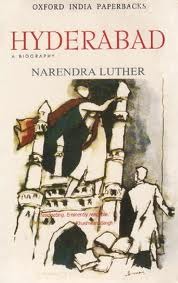 If a city’s raison d’etre is to make life better — Hyderabad is one of its kind. Hyderabad sits nestled amongst one of the oldest rock systems of the world. Hyderabad is the daughter of Golconda Fort which was built during Kakatiya rule — after the fall of the Kakatiya dynasty and a series of events Golconda Fort fell into the hands of Persians — Qutb Shahi dynasty. When Golconda Fort became congested with people teeming and hygiene could not be maintained, Quli passed a decree ordering the establishment of a new city which should be a replica of heaven on earth and unequalled in the world. Then, on an auspicious day when the moon was in the constellation of Leo and Jupiter was in its own mansion, a city is born — Hyderabad. Since then Hyderabad has attracted people from all over the world for a variety of reasons. Its climate, its cosmopolitanism, its growth — Hyderabad a biography is living relic of the city, starting with the period prior to the city’s birth in 1591, the book presents an unbroken and colourful chronicle of Hyderabad, one of contemporary India’s most important cities. Charting the city’s fascinating march from Bhagnagar to Hyderabad to Cyberabad, this story is replete with diverse engaging, eccentric and often daring characters, some of whose lives are stranger than fiction!
If a city’s raison d’etre is to make life better — Hyderabad is one of its kind. Hyderabad sits nestled amongst one of the oldest rock systems of the world. Hyderabad is the daughter of Golconda Fort which was built during Kakatiya rule — after the fall of the Kakatiya dynasty and a series of events Golconda Fort fell into the hands of Persians — Qutb Shahi dynasty. When Golconda Fort became congested with people teeming and hygiene could not be maintained, Quli passed a decree ordering the establishment of a new city which should be a replica of heaven on earth and unequalled in the world. Then, on an auspicious day when the moon was in the constellation of Leo and Jupiter was in its own mansion, a city is born — Hyderabad. Since then Hyderabad has attracted people from all over the world for a variety of reasons. Its climate, its cosmopolitanism, its growth — Hyderabad a biography is living relic of the city, starting with the period prior to the city’s birth in 1591, the book presents an unbroken and colourful chronicle of Hyderabad, one of contemporary India’s most important cities. Charting the city’s fascinating march from Bhagnagar to Hyderabad to Cyberabad, this story is replete with diverse engaging, eccentric and often daring characters, some of whose lives are stranger than fiction!
The Untold Hyderabad!
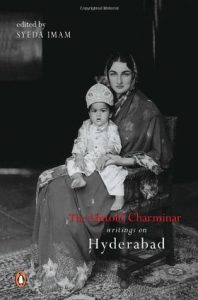 Whenever and wherever I mention that I live in Hyderabad, I am subjected to a pyroclastic flow of Hyderabad’s glorious past gushing out with a sense of pride — my tone shrieks with exclamation marks when I have to say Hyderabad!! Hyderabad founded by Quli Qutb Shah with a city plan ready in 1591, incorporating many of the features of the mythical Islamic heaven, now abounds in recurrent images, phrases — and stories that are less myth more truth, than most. There is something drone-like about the cliches; the state long presided over by the world’s richest man, home to the Salar Jung Museum, the Charminar, the Golconda diamonds, and the most likely to the Kohinoor, the Orloff, the Jacob, the Hope, the Great Mughal, the Darya-i-Noor. Hyderabad is a distinct Deccani culture, the product of a very particular mixture of peoples and influences. It was based on religious tolerance, courtesy, hospitality, love of arts and a first-rate civil service which made no distinction between creeds or caste or class. Religious tolerance —that rare value of accepting different cultures readily — has been an integral part of the culture of the Deccan for good reason. This hair-raising book, the untold Charminar’, Syeda Iman is a gleaning of many who touched the city and were moved; who know and will tell; who relish and wish to share that relish. Finally, although the Hyderabad that I reckon — the city of pearls, the city of lakes, the city of gardens has died, Hyderabad lives on!!
Whenever and wherever I mention that I live in Hyderabad, I am subjected to a pyroclastic flow of Hyderabad’s glorious past gushing out with a sense of pride — my tone shrieks with exclamation marks when I have to say Hyderabad!! Hyderabad founded by Quli Qutb Shah with a city plan ready in 1591, incorporating many of the features of the mythical Islamic heaven, now abounds in recurrent images, phrases — and stories that are less myth more truth, than most. There is something drone-like about the cliches; the state long presided over by the world’s richest man, home to the Salar Jung Museum, the Charminar, the Golconda diamonds, and the most likely to the Kohinoor, the Orloff, the Jacob, the Hope, the Great Mughal, the Darya-i-Noor. Hyderabad is a distinct Deccani culture, the product of a very particular mixture of peoples and influences. It was based on religious tolerance, courtesy, hospitality, love of arts and a first-rate civil service which made no distinction between creeds or caste or class. Religious tolerance —that rare value of accepting different cultures readily — has been an integral part of the culture of the Deccan for good reason. This hair-raising book, the untold Charminar’, Syeda Iman is a gleaning of many who touched the city and were moved; who know and will tell; who relish and wish to share that relish. Finally, although the Hyderabad that I reckon — the city of pearls, the city of lakes, the city of gardens has died, Hyderabad lives on!!
That which is not…
The spiritual journey is a journey towards clarity, but never towards certainty. When you draw conclusions about beginnings and endings, you are a believer. When you accept that you really do not know anything, you become a seeker. To be enlightened is not a condition of certainty. It is to move from limited knowing to boundless unknowing, from gravitas to grace.
Yogic science is a realm where science turns subjective, where fact and fable, poetry and profundity, magic and logic become inextricable.
An identified intellect leaves you with a completely distorted experience of reality. The human struggle is just this: you are unwilling to shake off the bits and pieces of knowledge you have acquired because these give you some sense of security and identity. For a tiny bit of knowledge, you are giving up the cosmos!
To know the life in its entirety, one has to become one with it — not cerebrally, but experientially. Through only knowing, not knowledge. Knowledge is intellectual accumulation; it is information gathered and processed in bits and pieces. Knowing, on the other hand, is neither intellectual nor accumulative.
Being that which is not is the most auspicious thing, this is because you can find fault ‘that which is ‘. You can like it or dislike it; you can agree with it or disagree with it; but ‘that which is not’ is perfect. ‘That which is not’ is the most auspicious, because nobody can find fault with it.
Musings!
One day a bull was grazing in the field and a pheasant was picking out the ticks off the bull’s body. They are used to each other; they are sort of friends, so it’s going on. Then the pheasant became nostalgic and said, “when I was young, I could fly and sit on the topmost branch of the big tree out there, but now I can’t even get to the first branch”. The bull said nonchalantly, “Oh! what’s the problem? Just eat my dung, and it will give you all the nourishment that you need to go to the topmost branch”. The pheasant said, “Really? You mean just eating your droppings will get me to the top of the tree?” “Yes, try and see!” he replied. So the pheasant hesitantly ate some of the dung, and that very day he flew up to the first branch! Every day, he started eating more and more of the dung. In about a fortnight’s time, it reached the topmost branch, and went and sat there. The pheasant was so thrilled, having eaten this dung and being able to sit on the topmost branch. Now when the farmer, who was sitting on his balcony, saw this fat pheasant sitting on the topmost branch of the tree, he just pulled out his shotgun and shot the pheasant off the tree!
The moral of the story is: bullshit may get you to the top but it will never let you stay there…!
Source: Mystic Musings – Sadhguru!
OFDM
Data rate is same as single carrier modulation. But when the coherence bandwidth is less than the bandwidth of the signal (in case of wide-band channels), single carrier modulation suffers from inter symbol interference (ISI). Whereas in multi-carrier modulation the bandwidth is divided into sub-carriers with bandwidth less than the coherence bandwidth; it’s more like converting wide-band into narrow band channels.
Thus OFDM converts frequency selective fading channel into flat fading channel.
Since multi-carrier modulation requires many modulators/demodulators for the transmission of the data, OFDM comes with IDFT (done by IFFT) which maps the data onto the respective sub-carrier, and can be transmitted.
A ZP–OFDM system has lower transmission power and a simpler transmitter structure. Unfortunately, the ZP–OFDM scheme introduces ICI, as the orthogonality among subcarriers is destroyed when multiple
copies of the time-shifted ZP–OFDM waveform are received. To remove ICI, cyclic
prefixing (CP) transmission is preferred.
Cyclic prefix converts the linear convolution into circular convolution, thus DFT can be invoked on the received signal.
In MIMO-OFDM each transmit antenna implements OFDM and transmit. Say, we have 4 antennas and 256*4 symbols to transmit, divide the 256 into 4 sets; and implement OFDM using the 256 sub-carriers at each antenna and transmit.
OFDM has high PAPR, which results in the non-linear region of the amplifier (in IFFT block). Thus high PAPR makes OFDM loses its properties such as orthogonality of the carriers.
Equalization at the receiver is done to mitigate the ISI, equalizers such as ZF equalizer, MMSE, decision feedback equalizer (check Goldsmith’s book) are used.
[draft]
Life 11
This is the day when I met Ramachandra Guha, a historian and biographer, at IISc Bangalore. I was completely enthralled and engrossed in reading his most acclaimed book India After Gandhi; it was first historical, non-fiction and a colossal book that I read. Below is the autographed copy of the book by Guha.
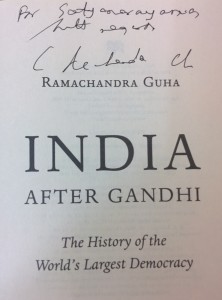
A fable on why reading is so important!
I recently picked up interest in reading books, mostly non-fiction, biographies ,and some philosophical stuff. I found the following interesting fable on quora on why reading is so important, and hence, sharing it here on my blog!
An old farmer lived on a farm in the mountains with his young grandson. Each morning Grandpa was up early sitting at the kitchen table reading his book. One day the grandson asked, “Grandpa! I try to read the book just like you but I don’t understand it, and what I do understand I forget as soon
as I close the book. What good does reading the book do?”
The grandfather quietly turned from putting coal in the stove and replied, “Take this coal basket down to the river and bring me back a basket of water.”
The boy did as he was told, but all the water leaked out before he got back to the house. The grandfather laughed and said, “You’ll have to move a little faster next time,” and sent him back to the river with the basket to try again. This time the boy ran faster, but again the basket was empty before he returned home. Out of breath, he told his grandfather that it was impossible to carry water in a basket, and he went to get a bucket instead. The old man said, “I don’t want a bucket of water; I want a basket of water. You’re just not trying hard enough,” and he went out the door to watch the boy try
again. At this point, the boy knew it was impossible, but he wanted to show his grandfather that even if he ran as fast as he could, the water would leak out before he got back to the house. The boy again dipped the basket into the river and ran hard, but when he reached his grandfather the basket was
again empty. Out of breath, he said, “See Grandpa, it’s useless!”
“So you think it is useless?” the old man said, “Look at the basket.” The boy looked at the basket and for the first time realized that the basket was different. It had been transformed from a dirty old coal basket and was now clean, inside and out.
Son, that’s what happens when you read the book. You might not understand or remember everything, but when you read it, you will be changed, inside and out!
